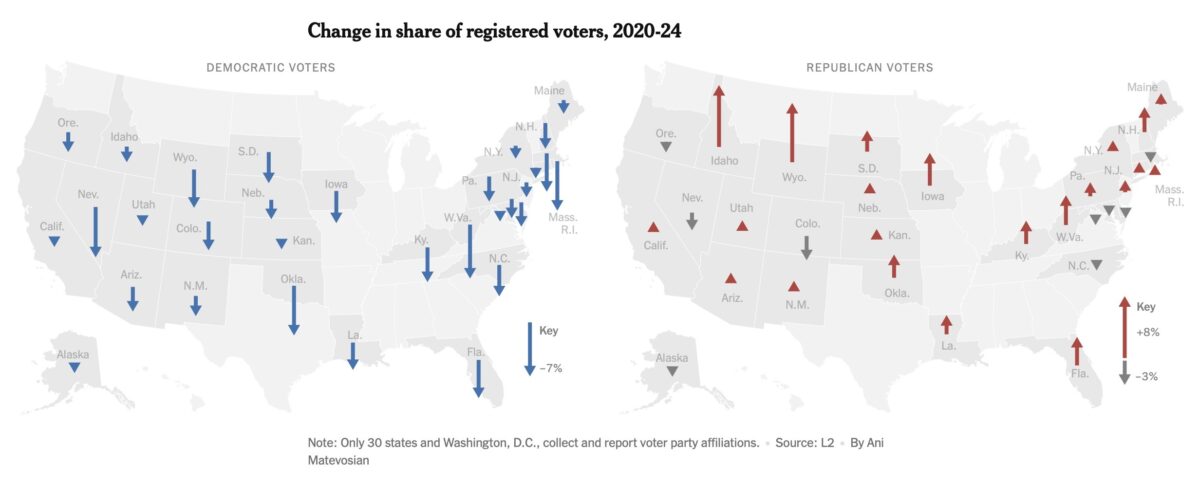Democrats Getting Clobbered by GOP in Voter Registration Nationwide, ‘Cratering’ with New Voters

Photo by lamenta3 on Flickr, licensed under CC BY-SA 2.0.
The Democratic Party is mired in a “voter registration crisis,” reported The New York Times on Wednesday, falling far behind the GOP nationally, in battleground states and deep red and blue states — and getting absolutely annihilated with new voters.
The report by Times national political correspondent Shane Goldmacher and data journalist Jonah Smith paints a grim picture for Democrats hoping to retake the House and Senate in 2026 and White House in 2028, along with all the critical statewide electoral battles.
While it is true that recent trends have an increasing number of voters registering as independents or not affiliated with a party, the exodus from partisan affiliation has hit Democrats measurably harder than Republicans.
“The Democratic Party is hemorrhaging voters long before they even go to the polls,” the article begins, highlighting how in the 30 states plus Washington, D.C. that register voters by political party, “Democrats lost ground to Republicans in every single one between the 2020 and 2024 elections — and often by a lot.”

Screenshot via The New York Times.
Over the past four years, according to the Times analysis, the Republicans picked up a 4.5 million voter advantage, “a deep political hole that could take years for Democrats to climb out from.” That figure comes from Democrats losing about 2.1 million registered voters and Republicans gaining 2.4 million, with Democrats dropping from “nearly an 11-percentage-point edge over Republicans on Election Day 2020 in those places with partisan registration, to just over a 6-percentage-point edge in 2024.”
It’s worth noting that the numbers might be even bleaker if red state Texas (the second largest population in the U.S.) registered voters by party, or blue state California (number one largest population) was not padding the Democratic side of the ledger.
The registration gap is especially stark when it comes to new voters, who were more likely to register as Republicans than Democrats in 2024, the first time that has happened since 2018.
Michael Pruser, the director of data science for Decision Desk HQ, told the Times, “I don’t want to say, ‘The death cycle of the Democratic Party,’ but there seems to be no end to this.”
“There is no silver lining or cavalry coming across the hill,” Pruser added. “This is month after month, year after year.”
President Donald Trump’s 2024 victory owed a lot to the Democrats’ lost ground in voter registration, with “significant Democrat erosion” shown in the battleground states of Arizona, Nevada, North Carolina, and Pennsylvania. “The party saw some of its steepest declines in registration among men and younger voters, the Times analysis found — two constituencies that swung sharply toward Mr. Trump,” the article notes.
One key challenge for Democrats hoping to reverse this downslide is the years of outsourcing voter identification and registration to outside nonprofit organizations. These PACs are “technically nonpartisan” to comply with IRS regulations but there had been an underlying assumption that targeting young and minority voters would yield mostly new Democrats. That isn’t necessarily a given, and official Democratic Party organizers have grumbled for years that these groups dazzle donors with lofty promises but are rarely able to deliver.
In an analysis I did of the GOP victories in the 2022 elections in Florida, which covered the flip from blue to red, I dug into the consequences of Joe Biden’s campaign forfeiting the 2020 race in the Sunshine State, deeming it too expensive and difficult to compete:
With Florida’s highly mobile population, the quality of any voter list quickly deteriorates, and by the time 2022 rolled around, the Democrats had gone four years without talking to Florida voters.
There were several 501(c)3 and 501(c)4 progressive groups active in Florida, but they diverted already-scarce resources away from [the Florida Democratic Party] and other official party organizations and their nonprofit status means they can’t recruit only Democrats for registration or outreach, can’t campaign for Democratic candidates individually or for the party slate, and can’t give their lists to Democratic campaigns. These organizations can go to areas where they expect the overall population to lean Democrat, like college campuses or metropolitan neighborhoods with deep-blue voting history, but they can neither target nor advocate directly as a candidate or party can, and their work leading up to the 2022 election was unable to have a measurable impact.
Beth Matuga, a veteran Democratic Party operative, has long held a deeply cynical view of these nonprofit groups, lamenting…they “have no accountability” and she’s never seen evidence that their claimed field operations are actually able to turn out voters for the Democrats.
As the Times observes, this is “a battle with hundreds of millions of dollars at stake, pitting partisans against philanthropists and some of the Democratic Party’s most important constituencies against one another.”
A confidential internal Democratic Party memo from early 2024 by data scientist Aaron Strauss warned that using these outside nonprofits to register young and minority voters, instead of actively recruiting new Democrats specifically, posed a risk of backfiring, a warning that proved to be prescient.
“If we were to blindly register nonvoters and get them on the rolls, we would be distinctly aiding Trump’s quest for a personal dictatorship,” wrote Strauss, because Trump was gaining ground among constituencies that had traditionally favored Democrats, destroying the much of the cost effectiveness of reaching out to these groups without being able to communicate clearly partisan messages.
Shifting away from these groups faces two strong headwinds: the millions of dollars the nonprofit PACs have raked in, motivating them to fight any suggestion their roles be diminished, and the tax breaks donors receive for contributing to them, which would not apply to donations to partisan PACs or official political party organizations.
So far this year, the numbers are not any sunnier for Democrats. The limited data available for the Times to review showed that since Election Day 2024, there are “now roughly 160,000 fewer registered Democrats” and “200,000 more Republicans.”




